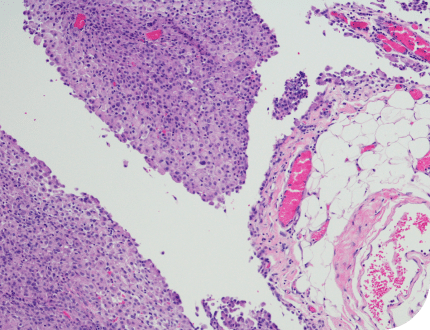Mesothelioma Latency Period
Mesothelioma’s latency period is the time between initial asbestos exposure and diagnosis, and it can range from 11 to 40 years, according to CDC findings. During this period, you may not experience symptoms, which can result in a delayed diagnosis at a late stage of the disease.
Home » National Mesothelioma Law Firm » Mesothelioma Cancer » Mesothelioma Latency Period
When exposed to asbestos, you typically do not experience symptoms to alert you that you have inhaled a dangerous substance. The microscopic fibers insidiously find their way into your bodily tissues, where they cause inflammation and ultimately lead to mesothelioma cancer and other deadly illnesses later in life. The time it takes for mesothelioma to develop after asbestos exposure is known as the latency period.
How Long Does Mesothelioma Take To Develop?
A South Korean study of 923 malignant mesothelioma patients published in the International Journal of Environmental Research and Public Health found an average latency period of 33.7 years.
This is consistent with findings by the Centers for Disease Control and Prevention, which reviewed 21 studies that identified 1,105 cases of mesothelioma after asbestos exposure. These studies found the following:
- A median mesothelioma latency period of 32 years
- A latency period of at least 20 years after the initial exposure in 96 percent of cases
- A latency period of at least 40 years in 33 percent of cases
- A minimum latency period of 11 years
There is, however, no “one size fits all” latency period when it comes to mesothelioma. In fact, the published scientific literature has linked cases of mesothelioma to asbestos exposures beginning less than 10 years before the victim’s diagnosis. For instance, Scansetti and colleagues reported the case of a gentleman diagnosed with pleural mesothelioma 7.5 years after his first exposure, and Bitchatchi et al. published the case of a woman diagnosed with pleural mesothelioma just 8.5 years after her earliest exposure to asbestos.
Does the Latency Period Change Based on the Type of Mesothelioma That Develops?
The scientific literature supports a variation in the mesothelioma latency periods for the different types of mesothelioma.
Pleural Mesothelioma
The latency for pleural mesothelioma plays the largest role in calculating the average mesothelioma latency because it accounts for 80 percent of cases. A study of 312 cases of pleural mesothelioma published in the European Journal of Cancer Prevention found an average latency of 48.7 years, with latency periods ranging from 14 to 72 years. The average age at diagnosis is 72.
However, the exact latency period varies in the studies. A 2009 study published in the Canadian Journal of Surgery found an average latency period of 30 to 40 years for pleural mesothelioma. The Great Britain Asbestos Survey by G. Frost found a median latency of 22.9 years.
Peritoneal Mesothelioma
The latency for peritoneal mesothelioma, the second most common type, tends to be shorter than pleural mesothelioma, according to the studies. The Canadian Journal of Surgery found a latency period of 20 to 30 years for peritoneal mesothelioma, and Frost’s findings pointed to a latency of just 8.2 years.
According to a 20-year Norwegian study published in Acta Oncologica, the average age at diagnosis for people with peritoneal mesothelioma is lower than in pleural mesothelioma cases. The study found a median age of 67 at peritoneal mesothelioma diagnosis for both genders, compared to an average age of 76 in men and 73 in women diagnosed with pleural mesothelioma.
Peritoneal mesothelioma is associated with heavier asbestos exposures. According to an Australian study published in Thorax, the risk of developing peritoneal mesothelioma after asbestos exposure never stops increasing. This is in contrast to the risk of pleural mesothelioma, which the study found increases for the first 45 years after exposure, after which time the risk curve flattens out.
Pericardial Mesothelioma
Pericardial mesothelioma is rare, and the available data is limited. A study of pericardial mesothelioma published by Elsevier found an average age at diagnosis of 50, indicating a latency period that may be shorter than peritoneal mesothelioma.
Testicular Mesothelioma
Testicular mesothelioma is believed to have an average latency period similar to pleural mesothelioma. However, it can be much shorter. Up to 10 percent of patients with this diagnosis are younger than 25.

Why Does Mesothelioma Have Such a Long Latency Period?
During the mesothelioma latency period following asbestos exposure, inflammation develops as the body attempts to break down or expel the fibers. However, asbestos is virtually indestructible, so they remain permanently embedded in the body’s tissues.
According to the American Lung Association, mesothelioma develops as a result of the following gradual process:
- Asbestos fibers are inhaled.
- The fibers travel through the smallest airways and into the lungs or other tissues.
- The tissues become irritated, and inflammation occurs.
- Over time, this inflammation leads to mutations, or damage to the DNA of the cells.
- Certain mutations result in cells multiplying uncontrollably.
- The out-of-control cell growth results in tumors.
DNA damage is a gradual process. As new cells are created and old cells die in the tissues where the asbestos has become embedded, each new generation of cells is slightly damaged.
The damage from one year to the next may not be significant enough to result in detectable illness, but after years of increasingly damaged cell generation, the cells become more likely to experience DNA damage that leads to the formation of a tumor.
How Does Asbestos Exposure Affect Mesothelioma Latency?
More studies are needed to determine whether certain characteristics related to the asbestos itself are predictive of the latency period. However, the data in some studies suggests certain correlations.
Asbestos Fiber Burden
Does the density of asbestos fibers decrease the mesothelioma latency period? A study of 594 mesothelioma patients published in Carcinogenesis found a positive correlation between asbestos fiber burden and age at diagnosis. People with higher asbestos fiber counts in their tissues tended to be younger when they were diagnosed with mesothelioma. Each time fiber counts were doubled, the patients were 1.13 times more likely to be diagnosed at a younger age.
Asbestos Type
Crocidolite is considered to be the most dangerous form of asbestos, due to the sharp, needlelike characteristics and small diameter of this amphibole type of asbestos. According to the South Korean study, exposure to crocidolite asbestos may decrease latency compared to the more common chrysotile type. Chrysotile asbestos forms curly fibers, while amphibole asbestos fibers are straight and sharp, making it easier for them to penetrate into human tissues.

A study published in Environmental Health also found a correlation between short asbestos fibers and a shorter latency period.
Individual Factors That Affect Mesothelioma Latency
Factors relating to the nature of your asbestos exposure and your individual physical characteristics may influence the asbestos-related mesothelioma latency period.
Source of Exposure
According to the South Korean study, occupational exposure is associated with shorter latency periods than environmental exposure.
Occupational asbestos exposure typically results in the heaviest levels of exposure because workers may handle the mineral directly. The work may be done in enclosed spaces with poor ventilation, and exposure often occurs over an extended period of time. Prolonged, heavy exposure can result in an especially high fiber burden.
Environmental exposure occurs when people are passively exposed to asbestos, even though they are not directly handling it. Examples of environmental asbestos exposure include the following:
- Naturally-occurring asbestos
- Asbestos in schools
- Secondary asbestos exposure
Environmental exposures to asbestos tend to be less concentrated, resulting in a lower fiber burden than occupational exposure. This could explain the difference in latency.
Occupation
The European Journal of Cancer Prevention published a study that demonstrates that your occupation can influence the mesothelioma latency period. According to the findings, the average latency periods for certain occupations with high exposure levels are as follows:
Occupation
Average Latency Period
Insulators
29.6 years
Dock workers (longshoremen)
35.4 years
Industrial workers
43.7 years
Non-industrial workers
46.4 years
Shipyard workers
49.4 years
Shipyard workers
49.4 years
Maritime trades
56.2 years
Age at First Exposure
According to the study by Frost, younger age at the time of exposure is associated with a longer latency period.
Age at First Exposure
Median Latency Period
Below 20
40.6 years
20-29
34.5 years
30-39
30.2 years
40-49
18.2 years
50 and older
10.7 years
This may correspond with the level of immune function at each age, as the immune system tends to be more efficient at younger ages. A healthy immune system can sometimes eliminate abnormal cells before they have a chance to grow into a tumor, which reduces the risk of cancer.
Gender
After adjusting for other variables, Frost found that women had a 29 percent longer latency period than men. According to the study published by Thorax, women with occupational exposure had a shorter latency than women whose asbestos exposure was secondary, which is consistent with the results of other studies regarding occupational asbestos exposure.
Genetics
Genetic mutations can impact the risk of many types of cancer, including mesothelioma. People with the BAP1 germline mutation may experience shorter latency periods than those without it, with an average age at diagnosis of 56.3 compared to 72 for the general population, according to European Review for Medical and Pharmacological Sciences. The same publication also reported another study that found an average age at diagnosis of 58.5 for people with this mutation, compared to 68.2 for the general population.
Presence of Asbestosis
Asbestosis is a disease caused by asbestos exposure, in which scar tissue builds up in the lungs. This disease is not malignant but is a strong indicator that a person has been exposed to high levels of asbestos. In the British study, Frost found that the latency period for mesothelioma was approximately five percent shorter in patients who also had asbestosis at the time of death.
Does Smoking Influence Mesothelioma Latency?
The South Korean study found a slightly shortened latency in smokers, but this was not linear. Numerous studies have found no direct causal relationship between mesothelioma and smoking. The shortened latency period could be caused by reduced immune function brought on by smoking. By contrast, the British study found no association between smoking and mesothelioma latency. More research is needed to clarify the nature of the relationship between these two factors.
The Relationship Between Latency and Diagnosis
The mesothelioma latency period often results in mesothelioma symptoms emerging at older ages, when they could easily be mistaken for signs of aging, the flu, or other more common, less serious conditions. When exposure occurred many decades prior, you may not remember or even be aware of it.
A mesothelioma diagnosis is difficult to confirm, and these factors can prevent the condition from being investigated. As a result, diagnosis may be delayed until the condition has reached a late stage.
Does Mesothelioma Latency Affect Prognosis?
A mesothelioma late-stage diagnosis is associated with a poorer prognosis. Even when it’s diagnosed during the early stages, the life expectancy of a patient with pleural mesothelioma is less than two years. If the diagnosis is delayed until the disease reaches stage four (the final stage), life expectancy drops to 12 months.
According to Lung Cancer International, only four percent of mesothelioma patients are diagnosed before the age of 45, and approximately two-thirds are 65 or older. At these ages, the immune system is less efficient, chronic conditions like diabetes are more common, and multiple medications may have to be managed. This could complicate treatment and reduce your options.
According to the American Society of Clinical Oncology, even healthy older adults may respond differently to treatment than younger people and older adults are more likely to experience serious side effects from chemotherapy. Surgery risks also tend to be higher in the elderly, and some older adults are not candidates for surgery at all.
Fewer treatment options and stronger side effects could adversely impact your mesothelioma prognosis. However, many older adults do respond well to conventional cancer treatment. Selecting a specialized mesothelioma treatment center will help you obtain access to the individualized treatment options you need.
The Lanier Law Firm Can Help
If you have been diagnosed with mesothelioma at any age, you may deserve compensation. Our mesothelioma lawyers have more than 30 years of experience helping individuals get justice against the large asbestos companies that knowingly exposed them to asbestos without their knowledge or consent.
We have won nearly $20 billion in verdicts and settlements for our clients. You can count on our award-winning attorneys to go to whatever lengths are necessary to win you the compensation you need. Contact us today for a free consultation.
By submitting this form, you agree to our terms & conditions. Please read full disclaimer here.



